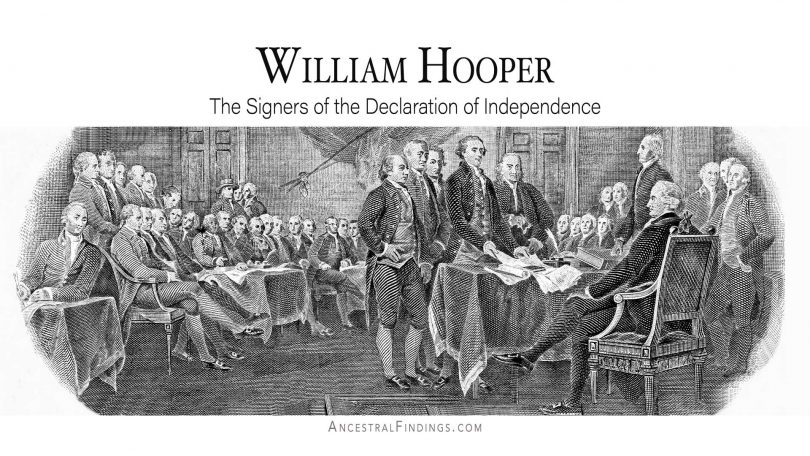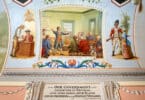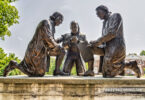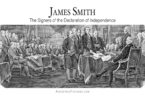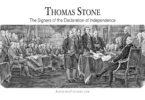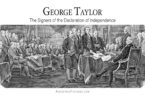William Hooper was the eldest of five children born in Boston, Massachusetts to William Hooper and Mary Dennie. William’s father was a minister from Scotland, who had studied at the University of Edinburgh before moving to Boston. His mother’s father was a well-respected Boston merchant. Therefore, young William’s family, while they may not have been wealthy, made a respectable and comfortable living, and were considered a highly regarded family by their peers and neighbors.
William’s father wanted him to become a minister, too. To this end, he made sure William got a good education. He enrolled William in John Lovell’s Boston Latin School when he was seven, and William entered Harvard University when he was sixteen years old. At Harvard, William was considered an industrious student and esteemed by his teachers and peers alike.
After he graduated Harvard with honors in 1760, William decided that he did not want to become a minister like his father, and instead wanted to become a lawyer. He began studying law under a local and well-respected attorney named James Otis. Otis was also considered a political radical. After passing the bar exam in 1764, William moved to North Carolina to begin his law practice, as he believed that Boston had too many lawyers practicing there all ready for him to be able to make good room for his own practice.
William temporarily settled in Wilmington, North Carolina, and began practicing law there. He became the circuit court lawyer in that area and began to build his good reputation among the wealthy farmers there, as well as among his fellow lawyers. He represented the colonial government in several court cases, which increased his excellent reputation and influence.
During the time he was practicing law in the Wilmington area, William married Anne Clark, who was the daughter of a wealthy man who was an early settler in the area, as well as the local sheriff of New Hanover County. Together, they had a son named William in 1768, a year after they wed. A daughter named Elizabeth followed in 1770, and then a son named Thomas in 1772.
While building his practice and building his family, William was able to move up the ranks in the lawyer class in Wilmington relatively quickly, and with ease. In 1769, he was appointed to the post of Deputy Attorney of the Salisbury District. In 1770, he was appointed to the post of Deputy Attorney General of North Carolina.
When he first began his law practice, William supported the British colonial government. He even worked with North Carolina’s colonial governor, William Tryon, to put down a group of rebels known as the Regulators. One report from the time period says that a group of Regulators dragged William through the streets during a 1770 riot. William advised the governor to use as much force as was necessary to put down the Regulators. He even went with the troops to the Battle of Alamance in 1771. In 1775, William served in the Province of North Carolina House of Burgesses.
While William’s support of the colonial government began to subside, later on, he had already gained a reputation for himself as a Loyalist to the crown. Therefore, when he became supportive of the cause of independence, it took a while for the patriots to accept him. When they did accept him, though, they did so with enthusiasm. He proved himself to the patriot cause when he was elected to the North Carolina General Assembly in 1773, where he opposed attempts by the colonial government to pass laws that would regulate the provincial courts.
This opposition brought down his reputation among the Loyalists. That was okay by William by this time, as he recognized that a bid for independence was almost certainly to be made by the colonies, and he was all for it.
William helped form a new colonial assembly after the governor disbanded the previous one. He was appointed to the Committee of Correspondence and Inquiry on this assembly. He was selected as a delegate to the First Continental Congress in 1774, and he went there and served on several committees. After his time there, he was appointed to the Second Continental Congress. However, during the second congress, much of William’s time was divided between his work there and his work in North Carolina, where he was helping to form a new colonial government. Because of his work in North Carolina, William missed the vote to approve the Declaration of Independence, but he arrived back at the congress in time to sign his name to the Declaration.
William resigned from the Continental Congress in 1777 because of financial concerns. He went home to North Carolina and began practicing law there once more. The American Revolution was in full swing by then, and now as a known Patriot, William was the subject of several attempted captures by British troops. Because his home was in a place that left it vulnerable to the British, William moved his family from the country outside Wilmington to Wilmington city proper. Yet, the British captured Wilmington in 1781, and William was separated from his family to keep them all safe. During this time, he was moved among the houses of his friends, who provided him with food and shelter while hiding him. He also had to nurse himself back to health during this time after getting malaria. After about a year of being separated from his family, William was reunited with his wife and children, and they went to settle in Hillsborough, North Carolina. William continued to work on the North Carolina Assembly there until 1783.
William kept up his law practice after the Revolution, though his reputation was somewhat tarnished by what others saw as his too-soft dealings with Loyalists. Some even accused William of being a Loyalist himself. Still, William campaigned heavily in favor of adopting the new US Constitution in 1787 and 1788. Shortly after this, William became ill with some unnamed cause and crossed to the other side on October 14, 1790. He was buried at the Presbyterian Churchyard in Hillsborough, North Carolina. Later, he was moved to the Guildford Courthouse National Military Park. His house in Hillsborough, called the Nash-Cooper House, located in the Hillsborough Historic District, was declared a National Historic Landmark in 1971.

